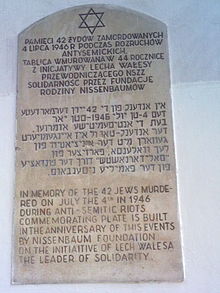| Kielce pogrom | |
|---|---|
| Part of anti-Jewish violence in Poland, 1944–1946 | |
 Plaque on ulica Planty 7, Kielce, dedicated by Lech Wałęsa, 1990 | |
| Location | Kielce, Poland |
| Date | 4 July 1946 Morning until evening (official cessation at 3 p.m.) |
| Target | Polish Jews |
| Deaths | 38 to 42 Jews |
| Motive | Blood libel |
| Convicted | 39 convicted (9 executed) |
The Kielce pogrom was an outbreak of violence toward the Jewish community centre's gathering of refugees in the city of Kielce, Poland, on 4 July 1946 by Polish soldiers, police officers, and civilians[1] during which 42 Jews were killed and more than 40 were wounded.[1][2] Polish courts later sentenced nine of the attackers to death in connection with the crimes.[1]
As the deadliest pogrom against Polish Jews after the Second World War, the incident was a significant point in the post-war history of Jews in Poland. It took place only a year after the end of the Second World War and the Holocaust, shocking Jews in Poland, non-Jewish Poles, and the international community. It has been recognized as a symptom of the precarious condition of Eastern European Jewish communities in the aftermath of the Holocaust and as a catalyst for the flight from Poland of most remaining Polish Jews who had survived the war.[3][4]
- ^ a b c The Kielce Pogrom: A Blood Libel Massacre of Holocaust Survivors Archived 24 November 2016 at the Wayback Machine
- ^ Interview with Krzysztof Kąkolewski, Archive copy at the Wayback Machine Also available with purchase at "To Moskwa zaplanowała ten mord" (The murder was planned in Moscow), Tygodnik Angora – "Przegląd prasy krajowej i światowej", Łódź, 29/2006 (839); section Kultura, p. 56. Copy available at Forum historycy.org, 3 July 2006, and at Gazeta.pl Forum (incomplete) Archived 7 March 2012 at the Wayback Machine, 7 June 2016. (in Polish)
- ^ Cite error: The named reference
patternswas invoked but never defined (see the help page). - ^ "The Kielce Pogrom: A Blood Libel Massacre of Holocaust Survivors". Holocaust Encyclopedia. United States Holocaust Memorial Museum. Retrieved 1 March 2023.